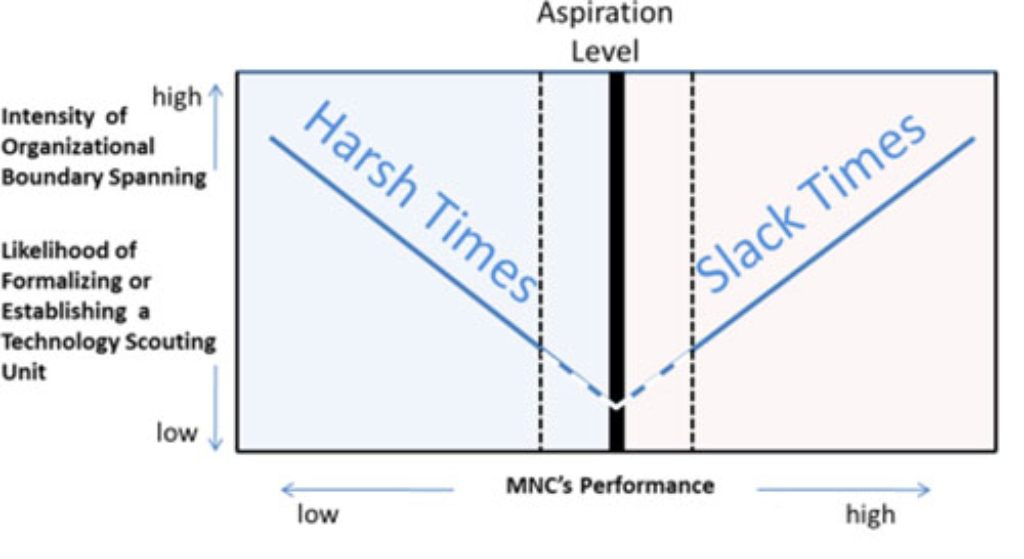
IESE Insight
For better, for worse: Why companies turn to tech scouts
To innovate faster, develop superior products, and perform better financially, corporations should look outside their own organizations with tech scouting.
What do Bayer, Siemens and British Telecom have in common? All three companies have successfully tapped into innovation outside their boundaries to innovate and grow in their respective industries.
In recent decades, more multinationals than ever are spanning the boundaries of their organization in order to tap into new knowledge. Many have dedicated units to this — often labeled "technology scouting units" — which search for and then incorporate external knowledge into the business.
There's good reason for this. According to studies, the companies that source knowledge externally display many advantages: they develop superior products, innovate faster and tend to perform better financially.
Boundary spanning clearly improves company performance. But how does company performance affect boundary spanning? Does the company's performance influence its decision to look outside itself in the first place? And do companies performing relatively well (in line with their aspirations) approach the process differently, compared with companies that are performing poorly (i.e., under their aspirations)?
IESE's Thomas Klueter and Felipe Monteiro offer a theoretical model and draw support for it with 15 in-depth interviews of senior managers in multinational companies who had direct experiences with boundary spanning and technology scouting. The authors conclude that boundary spanning is most likely to happen when a business is performing either very well or poorly, compared to their aspirations. In contrast, when companies perform close to their aspirations, not much effort is put into seeking external innovation.
What's more, those struggling and thriving companies are using tech scouts in very different ways, as the authors explain in their article published in the Journal of Management Studies.
In hot pursuit of knowledge
When performance is below expected levels (i.e., in harsh times), companies tend to intensify scouting efforts to bring back new knowledge. For managers under pressure to improve company performance, scouting is a way to find a quick-fix or ready-to-use solution to their problems.
But when performance is strong (i.e., in slack times), companies innovate to maintain their precious competitive advantage. And when managers have more resources or "slack" to work with, they are likely to put significant effort into opportunistic boundary spanning — proactively looking for the "next problems" to drive future innovation. A senior executive responsible for external business development in a medical device multinational explained:
In 2011, the medical device unit had clearly outperformed the market over a longer time span.... Still, even when we were doing well .... there was an increasing appreciation that 99.9% of the science is beyond our labs.... During this time, we were asked to examine what was available [externally] in an exhaustive way. There was a general fear to not miss anything really important.
Figure 1 illustrates the predicated patterns.

Seeking "best in world"
One thing is going outside the company; another is looking beyond the country. Moving outside national boundaries to seek "best in world" knowledge can be valuable, but managers must weigh benefits against the costs and difficulties of international scouting.
These costs usually mean that companies in harsh times first focus on sourcing new knowledge on their home turf. However, when performance drops further, managers are often motivated to look abroad for solutions — so international boundary-spanning efforts rise in times of very poor performance.
But cash-strapped businesses cannot afford to bankroll long periods of boundary spanning, and during the periods they do fund, they often need to put local forms of scouting on hold to save resources. This means that in harsh times, national-boundary spanning is often done in punctuated, short bursts. Managers usually tell scouts to limit their efforts to spaces that can directly solve the organization's problems. As a scout from a German multinational explained: "The only good thing in [harsh times] is that I get very clear instructions... [The business unit contacts] will quickly tell me what they want and don't want [from China]."
In contrast, technology scouts in slack times benefit from extra time and resources which boost national boundary-spanning activities. Managers can also give scouts the freedom to be broader and more experimental in choosing which regions to tap for innovation. Managers often support simultaneous national and international scouting efforts in slack times, to maximize innovation.
Inside and out
But finding external knowledge is just one half of the scout's job. Scouts must integrate the new knowledge into the business, and they have to span internal boundaries (towards relevant business units) to do so. The way they engage in spanning such internal boundaries, again, depends on how the company is performing relative to its aspirations.
When times are harsh, tensions and tradeoffs mean that technology scouts are likely to present external knowledge as a ready-to-use solution to replace the company's current internal knowledge.
But in slack times, technology scouts are under less pressure to substitute internal knowledge. As a result, they tend to present external solutions as complementary to the company's research: they bring together outside innovation with the best inside knowledge.
At a German multinational, a manager in a role similar to a technology scout explained:
I still prefer the mode when things are going well as we have greater freedom to learn what is out there. The good thing is that they are interested in how what I find ultimately will help their [internal] R&D initiatives and help the [business] unit grow.... I showcase to them [the R&D unit managers] how what I find actually helps them achieve their goals.
So, when the company performs well, managers have greater freedom to direct boundary spanning that is broad and future-focused, and that can be combined with knowledge the company already has. During times of poor performance, managers are more likely to focus on sourcing short-term, ready-made external solutions and replacing internal company knowledge. Linking company performance with boundary-spanning practice shows us why managers behave differently in harsh and slack times.
These insights can help managers to reflect on how company performance shapes their decisions re: acquiring external knowledge. In particular, executives at firms performing close to their aspirations may be surprised to learn how their past performance may be hindering their future prospects. Understanding how feedback affects boundary spanning may help managers to break down their company's barriers to maximum innovation.
Methodology, very briefly
This paper offers a theoretical model, drawing from behavioral theory of the firm, as well as an analysis of data collected from 15 in-depth interviews conducted with senior industry professionals in European and North American multinational companies. The researchers carefully selected interview subjects who had experience with technology scouting or boundary-spanning business development across different industries (telecommunications, medical devices and pharmaceuticals).
